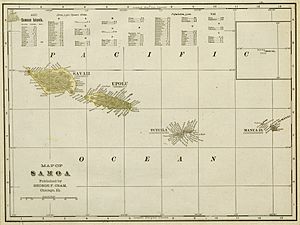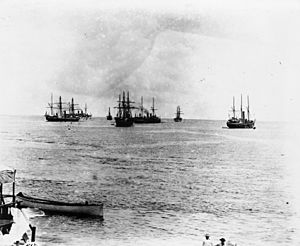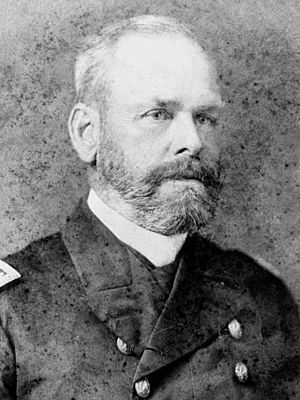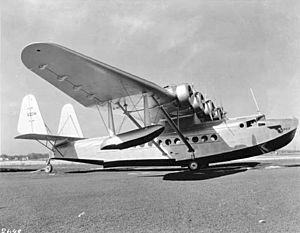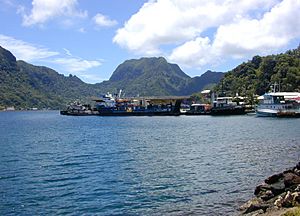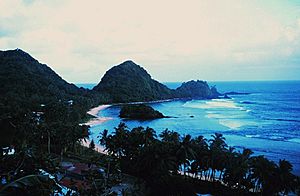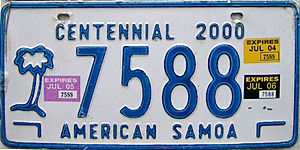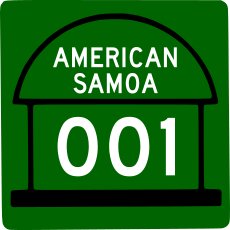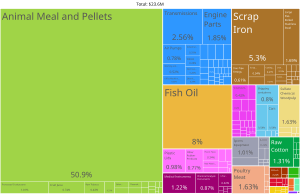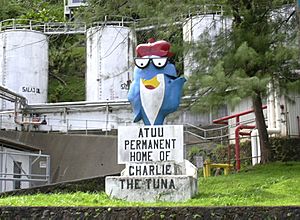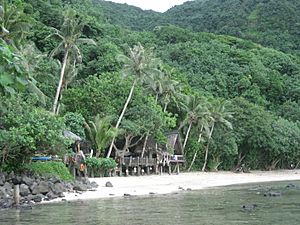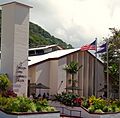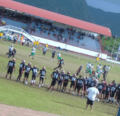American Samoa facts for kids
Quick facts for kids
American Samoa
Amerika Sāmoa
|
|||
|---|---|---|---|
|
|||
| Motto(s):
"Sāmoa, Muamua Le Atua" (Samoan) (English: "Samoa, Let God Be First")
|
|||
| Anthem: "Amerika Samoa" |
|||
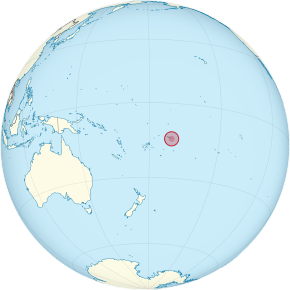
Location of American Samoa
(circled in red) |
|||
| Sovereign state | |||
| Partition of Samoa | December 2, 1899 | ||
| Ratification Act | February 20, 1929 | ||
| Capital | Pago Pago | ||
| Government seat | Fagatogo | ||
| Largest village | Tāfuna | ||
| Official languages |
|
||
| Ethnic groups | |||
| Religion |
|
||
| Demonym(s) |
|
||
| Government | Devolved presidential constitutional dependency | ||
| Joe Biden (D) | |||
|
• Governor
|
Lemanu Peleti Mauga (D) | ||
|
• Lt. Governor
|
Salo Ale (D) | ||
| Legislature | Fono | ||
| Senate | |||
| House of Representatives | |||
| Area | |||
|
• Total
|
77 sq mi (200 km2) | ||
| Highest elevation | 970 m (3,170 ft) | ||
| Population | |||
|
• 2021 estimate
|
46,366 (210th) | ||
|
• Density
|
670.8/sq mi (259.0/km2) | ||
| GDP (PPP) | 2016 estimate | ||
|
• Total
|
$658 million | ||
|
• Per capita
|
$11,200 | ||
| Currency | United States dollar (US$) (USD) | ||
| Time zone | UTC−11:00 (SST) | ||
| Date format | mm/dd/yyyy | ||
| Driving side | right | ||
| Calling code | +1-684 | ||
| USPS abbreviation |
AS
|
||
| ISO 3166 code |
|
||
| Internet TLD | .as | ||
American Samoa ( [Amerika Sāmoa also Amelika Sāmoa or Sāmoa Amelika] Error: {{Lang-xx}}: text has italic markup (help)) is an unincorporated territory of the United States located in the South Pacific Ocean, southeast of Samoa.
American Samoa consists of five main islands and two coral atolls. The largest and most populated island is Tutuila. Other islands and atolls included in the territory are the Manuʻa Islands, Rose Atoll, and Swains Island.
The U.S. 2020 census showed a total population of 49,710 people. The total land area is 76.8 square miles (198.9 km2), slightly more than Washington, D.C. American Samoa is the southernmost territory of the U.S. and one of two U.S. territories south of the Equator. The other territory that is south of the Equator is the uninhabited (nobody lives there) Jarvis Island. Tuna products are the main exports, and American Samoa's main trading partner is the United States.
During the 1918 flu pandemic, Governor John Martin Poyer quarantined the territory. Because of his quick action, American Samoa was one of the few places in the world where there were no flu-related deaths.
American Samoa has the highest rate of military enlistment (people who join the military) of any U.S. state or territory. As of September 9, 2014, the local U.S. Army Recruiting Station in Pago Pago enlisted the most soldiers out of the 885 Army recruiting stations and centers under the United States Army Recruiting Command (USAREC). This includes the 50 U.S. states, the District of Columbia, Puerto Rico, Guam, the Commonwealth of the Northern Mariana Islands, the Federated States of Micronesia, Palau, the Republic of the Marshall Islands, Korea, Japan, and Europe.
Most American Samoans are bilingual and can speak English and Samoan fluently. Samoan is the same language spoken in neighboring independent Samoa.
Contents
History
18th century: first western contact
Contact with Europeans on the Samoan Islands began in the early eighteenth century. Dutchman Jacob Roggeveen was the first known European to sight the Samoan Islands in 1722. This visit was followed by French explorer Louis-Antoine de Bougainville who named them the Navigator Islands in 1768. There was little contact before the 1830s, when English missionaries and traders began arriving on the islands.
A battle in the eighteenth century took place between French explorers and islanders in Tutuila. The site of this battle is called Massacre Bay. The Samoans were blamed in the West, and this made people believe that the natives were ferocious.
19th century
Mission work in the Samoas had begun in late 1830 when John Williams of the London Missionary Society arrived from the Cook Islands and Tahiti. By that time, the Samoans had gained a reputation for being savage and warlike because violent fights had occurred between natives and European visitors. However, by the late nineteenth century, French, British, German, and American ships regularly stopped at Samoa because Pago Pago Harbor was a refueling station for coal-fired shipping and whaling.
In March 1889, an Imperial German naval force entered a village on Samoa. When they did, they destroyed some American property. Three American warships then entered Apia Harbor and prepared to fight the three German warships found there. Before any shots were fired, a typhoon wrecked both the American and German ships. Because there were not warships to fight, the two countries were forced to call an armistice.
Early 20th century
The 1899 Tripartite Convention settled struggles between the three countries involved in the fight over the Samoan Islands:
- Britain gave up all claims to Samoa and in return accepted the end of German rights in Tonga and certain areas in the Solomon Islands and West Africa.
- The United States and Germany agreed to divide the Samoan Islands into two parts:
-
- 1. The eastern island group became a territory of the United States (the Tutuila Islands in 1900 and officially Manu'a in 1904) and is today known as American Samoa.
- 2. The western islands, the much larger section of land, became known as German Samoa.
U.S. Protectorate
The next year, the U.S. Navy formally occupied eastern Samoa for the United States government. The existing coaling station at Pago Pago Bay was grown into a full naval station, known as United States Naval Station Tutuila. The territory grew and became known as the U.S. Naval Station Tutuila.
On July 17, 1911, the U.S. Naval Station Tutuila, which included Tutuila, Aunu'u, and the Manu'a Island group (Ofu and Olosega -joined by a bridge- and Ta'u) was officially renamed American Samoa.
World War I and the 1918 flu pandemic

In 1918, during the final stages of World War I, the flu pandemic was spreading rapidly from country to country. American Samoa became one of only three places in the world (the others being New Caledonia and Marajó island in Brazil) to have prevented any deaths during the pandemic through the quick response from Governor John Martin Poyer. After hearing news reports of the outbreak on the radio, Poyer requested the use of quarantine ships from the U.S. mainland, so that the disease could be contained and not spread to American Samoa. The result of Poyer's quick actions earned him the Navy Cross from the U.S. Navy. American Samoans regarded Poyer as their hero for what he had done to prevent the deadly disease. The neighboring New Zealand territory at the time, Western Samoa (formerly German Samoa), suffered the most of all Pacific islands. 90% of the population became infected; 30% of adult men, 22% of adult women, and 10% of children died. Poyer offered to help Western Samoa, but the administrator, Robert Logan, refused to listen. Logan had become angry after seeing the number of quarantine ships surrounding American Samoa and had cut off communications with American Samoa.
Interwar period
American Samoa Mau Movement
After World War I, during the time of the Mau movement in Western Samoa (then a League of Nations mandate ruled by New Zealand), there was also an American Samoa Mau movement led by Samuelu Ripley, a World War I veteran who was from Leone, Tutuila. After meetings in the United States mainland, he was prevented from getting off the ship that brought him home to American Samoa and was not allowed to return because the American Samoa Mau movement was being stopped by the U.S. Navy. In 1930, the U.S. Congress sent a group of people to investigate the status of American Samoa, led by Americans who had a part in the overthrow of the Kingdom of Hawaii.
Annexation of Swains Island
Swains Island, which had been included in the list of guano islands and classified under the Guano Islands Act, was annexed (added) to American Samoa in 1925 by Pub. Res. 68–75.
Pan American and First Trans-South Pacific flight
In 1938, the famous aviator Ed Musick and his crew died on the Pan American World Airways S-42 Samoan Clipper over Pago Pago, while on a survey flight to Auckland, New Zealand. Sometime after takeoff, the aircraft experienced trouble, and Musick turned it back toward Pago Pago. While the crew dumped fuel to prepare for an emergency landing, an explosion tore the aircraft apart.
World War II and aftermath
During World War II, there were more U.S. Marines stationed in Samoa than people who lived there. The marines had an enormous cultural influence on the locals. Young Samoan men aged 14 and above were combat trained by U.S. military employees. Samoans served in various jobs during World War II, including soldiers, medical personnel, code personnel, and ship repairmen.
In 1949, Organic Act 4500, a U.S. Department of Interior-sponsored attempt to incorporate American Samoa, was introduced in Congress. The Samoans did not want to be incorporated, and the Samoan chiefs, led by Tuiasosopo Mariota, helped to defeat the act. The hard work of these chiefs led to the creation of a territorial legislature, the American Samoa Fono, which meets in the village of Fagatogo.
1951–1999
By 1956, Peter Tali Coleman, who was locally elected, replaced the U.S. Navy-appointed governor. American Samoa rules itself under a constitution that became effective on July 1, 1967. The U.S. Territory of American Samoa is on the United Nations list of Non-Self-Governing Territories, even though the territorial government officials disagree with their being included on the list.
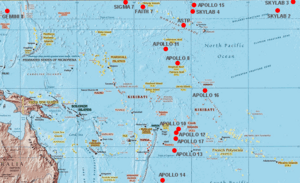
American Samoa and Pago Pago International Airport was involved with the Apollo Program. The astronaut crews of Apollo 10, 12, 13, 14, and 17 were picked up a few hundred miles from Pago Pago and brought by helicopter to the airport before being flown to Honolulu on C-141 Starlifter military aircraft.
While the two Samoas share language and ethnicity, the cultures of American Samoa and Western Samoa have recently followed different paths. Many American Samoans have emigrated to Hawaii and the U.S. mainland, and have adopted many U.S. customs, such as the playing of American football and baseball. Western Samoans have tended to emigrate instead to New Zealand, whose influence has made the sports of rugby and cricket more popular in the western islands.
21st century
Because of economic difficulty, military service has been seen as an opportunity in American Samoa and other U.S. overseas territories. Because so many American Samoans have joined the military, it has meant that a higher percentage of American Samoans have died in war compared to citizens of the United States. As of March 23, 2009, ten American Samoans had died in Iraq, and two died in Afghanistan.
Notable events
Pre-20th century
On December 10, 1787, French sailor Jean-François de Galaup, comte de Lapérouse landed two exploration parties on Tutuila's north shore: one from the ship La Boussole ("The Compass") at Fagasa, and the other from L' Astrolabe ("The Quadrant") at A'asu. On December 11, 1787, twelve members of Jean-François de La Pérouse's crew (including First Officer Paul-Antoine Fleuriot de Langle and 39 Samoans) were killed by angry Samoans at A'asu Bay, Tutuila. From then on, A'asu Bay has been called "Massacre Bay." This incident gave Samoa a reputation for savagery and kept Europeans away until the arrival of the first Christian missionaries four decades (forty years) later.
On March 25, 1891, Robert Louis Stevenson paid a rare visit to Pago Pago.
20th century
Visitors
Several famous people have visited American Samoa:
- On December 15, 1916, English writer William Somerset Maugham arrived in Pago Pago. He was inspired to write the short story "Rain" while he was there.
- On August 11, 1925, Margaret Mead arrived in American Samoa aboard the SS Sonoma to begin fieldwork for her doctoral dissertation in anthropology (the study of people and cultures).
- On August 24, 1943, First Lady Eleanor Roosevelt visited American Samoa and inspected the Fita Fita Guard and Band and the First Samoan Battalion of the U.S. Marine Corps Reserve at the U.S. Naval Station American Samoa.
- On October 18, 1966, President Lyndon Baines Johnson and First Lady Lady Bird Johnson visited American Samoa. The territory's only hospital was renamed in honor of President Johnson. Mrs. Johnson dedicated the "Manulele Tausala" ("Lady Bird") Elementary School in Nu'uuli, which was named after her.
- In November 1970, Pope Paul VI visited American Samoa in a short but lavish greeting.
Events
On January 11, 1942, at 2:26 a.m., a Japanese submarine surfaced off Tutuila between Southworth Point and Fagasa Bay. For 10 minutes, it fired about 15 shells from its 5.5-inch deck gun at the U.S. Naval Station Tutuila. The first shell struck the rear of Frank Shimasaki's store, ironically owned by one of Tutuila's few Japanese residents. The next shells did little or no damage to people or property. The naval station did not return fire. This was the only time the Japanese attacked Tutuila during World War II.
In the late 1960s and early 1970s, American Samoa played an important role in five of the Apollo Program missions. The astronauts landed several hundred miles from Pago and were brought to the islands on their way back to the mainland. President Richard Nixon gave three moon rocks to the American Samoan government, and these are on display in the Jean P. Haydon Museum, along with a flag carried to the moon on one of the missions.
On January 30, 1974, Pan Am Flight 806 from Auckland, New Zealand, crashed at Pago Pago International Airport at 10:41 p.m., with 91 passengers aboard. 86 people were killed, including Captain Leroy A. Petersen and the entire flight crew.
On April 17, 1980, a U.S. Navy patrol plane had its vertical stabilizer (the fin-like metal piece that sticks up in the back of the plane) shaved off by the Solo Ridge-Mount Alava aerial tramway cable that ran across Pago Pago Harbor. During the Flag Day celebrations, the plane was carrying six skydivers from the U.S. Army's Hawaii-based Tropic Lightning Parachute Club. After the skydivers had made their jump the plane crashed. The skydivers were reported to be in good condition, but the crash destroyed a section of the Rainmaker Hotel and killed all six crew members and one civilian. A memorial monument is built on Mt. Mauga O Ali'i to honor their memory.
21st century
On July 22, 2010, Det. Lt. Lusila Brown was shot and killed outside the temporary High Court building in Fagatogo. It was the first time since 1998 that a police officer was killed in the line of duty, when Sa Fuimaono drowned after saving a teenager from rough seas.
On November 7, 2010, United States Secretary of State and former First Lady Hillary Clinton stopped at the Pago Pago International Airport for fuel. She was greeted by government dignitaries and presented with gifts and a traditional 'ava ceremony (a ceremony in which a special beverage is shared to mark important occasions).
September 2009 earthquake and tsunami
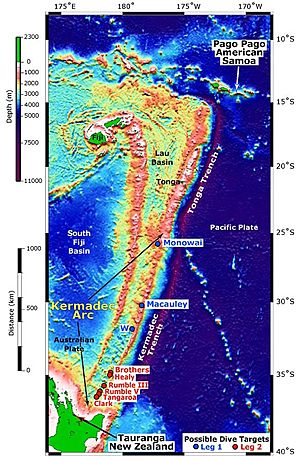
On September 29, 2009, at 17:48:11 UTC, an 8.1 magnitude earthquake struck 120 miles (190 km) off the coast of American Samoa, followed by smaller aftershocks. It was the largest earthquake of 2009. The quake occurred on the outer rise of the Kermadec-Tonga Subduction Zone. This is part of what is called the Pacific Ring of Fire, where tectonic plates in the Earth's lithosphere meet and earthquakes and volcanic activity are common. The quake struck 11.2 miles (18.0 km) below the ocean floor and started a tsunami that killed more than 170 people in the Samoa Islands and Tonga. Four waves with heights from 15 feet (4.6 m) to 20 feet (6.1 m) high were reported to have traveled up to one mile (1.6 km) inland on the island of Tutuila.
The Defense Logistics Agency (DLA) worked with the Federal Emergency Management Agency (FEMA) to provide 16 ft. × 16 ft. humanitarian (helpful) tents to the ruined areas of American Samoa.
Geography
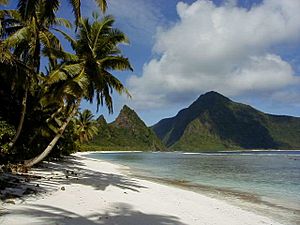
American Samoa, located within the geographical region of Oceania, is one of only two possessions of the United States in the Southern Hemisphere. The other is Jarvis Island. Its total land area is 76.1 square miles (197.1 km2) – slightly larger than Washington, D.C. – consisting of five rugged, volcanic islands and two coral atolls. The five volcanic islands are Tutuila, Aunu'u, Ofu, Olosega, and Tau. The coral atolls are Swains Island and Rose Atoll. Of the seven islands, Rose Atoll is the only uninhabited one; it is a Marine National Monument.
Due to its location in the South Pacific Ocean, it is often hit by tropical cyclones between November and April. Rose Atoll is the easternmost point of the territory. American Samoa is the southernmost part of the United States. American Samoa is home to the National Park of American Samoa.
Vailulu'u Seamount
The Vailulu'u Seamount, an active underwater volcano, lies 28 miles (45 km) east of Ta'u in American Samoa. It was discovered in 1975 and has since been studied by an international team of scientists. These studies have helped scientists understand the Earth's basic processes. Growing inside the summit crater of Va'ilulu'u is an active underwater volcanic cone, named after Samoa's goddess of war, Nafanua.
Climate
American Samoa has a tropical climate all year round with the average daily temperature around 81˚- 83˚ Fahrenheit (around 28° Celsius). It has two distinct seasons, the wet and dry seasons. The wet season is usually between December and March, and the dry season is from April through November.
Transportation
American Samoa has 150 miles of highways (estimated in 2008). The maximum speed limit is 30 miles per hour. Ports and harbors include Aunu‘u, Auasi, Faleāsao, Ofu, and Pago Pago. American Samoa has no railways. The territory has three airports, all of which have paved runways. The main airport is Pago Pago International Airport. According to a 1999 estimate, the country has no merchant marine.
Demographics
| Historical population | ||
|---|---|---|
| Year | Pop. | ±% |
| 1960 | 19,000 | — |
| 1970 | 27,159 | +42.9% |
| 1980 | 32,297 | +18.9% |
| 1990 | 46,773 | +44.8% |
| 2000 | 57,291 | +22.5% |
| 2010 | 55,519 | −3.1% |
| 2016 | 54,194 | −2.4% |
As of 2021, the population of American Samoa is about 54,390 people, 97% of whom live on the largest island, Tutuila. About 65% of the population are U.S. nationals, of whom at least 10% are U.S. citizens. Of the foreign-born population, 81% are from Samoa, 9% are from other parts of Oceania, and 9% are from Asia.
American Samoa is small enough to have just one ZIP code, 96799, and uses the U.S. Postal Service (state code "AS") for mail delivery.
Ethnicity and language
91.6% of the people who live in American Samoa are native Samoans, 2.8% are Asian, 1% are Caucasian, 4.2% are mixed, and 0.3% are of another origin. Most people are bilingual. Samoan, a language closely related to Hawaiian and other Polynesian languages, is spoken natively by 91% of the people. Samoan and English are the co-official languages of the territory. 80% of the people speak English, 2.4% speak Tongan, 2% speak Japanese and other Asian languages, and 2% speak other Pacific Islander languages. At least some of the deaf population uses Samoan Sign Language. Tokelauan is also spoken in Swains Island.
Religion
Major Christian denominations on the island include the Congregational Christian Church in American Samoa, the Roman Catholic Church, the Church of Jesus Christ of Latter-day Saints, Seventh-day Adventists, Pentecostals (including the Assemblies of God), Church of the Nazarene, Jehovah's Witnesses, Mormons, and the Methodist Church of Samoa. Altogether, these churches are attended by the majority of the population.
A major Protestant church on the island, gathering a large part of the local Protestant population, is the Congregational Christian Church in American Samoa, a Reformed denomination in the Congregationalist tradition. As of August 2022[update], The Church of Jesus Christ of Latter-day Saints website reports a membership of 16,512 or one-quarter of the whole population, with 43 congregations and 5 family history centers in American Samoa. It accounts for most of the other Christians.
Education
The island contains 23 primary schools and 10 secondary schools. Five are operated by the American Samoa Department of Education, and the other five are administered by either religious denominations or are privately owned. American Samoa Community College, founded in 1970, provides post-secondary education (after secondary education) on the islands.
Culture
The ethnic culture of American Samoa is almost the same as the ethnic culture of Western Samoa (Upolu and Savaii). The U.S. sovereignty separates the civilization of American Samoa from the sovereign Samoa.
Sports
The main sports played in American Samoa are Samoan cricket, baseball, basketball, soccer, and American football. In Samoan villages, volleyball is also popular.
American football
About 30 ethnic Samoans, all from American Samoa, currently play in the National Football League, and more than 200 play NCAA Division I college football. Junior Seau and Troy Polamalu are two of the most famous American Samoans to play for the NFL.
Association football (soccer)
American Samoa national association football team is one of the newest teams in the world, and is also known for being the world's weakest team. They lost to Australia 31–0 in a FIFA World Cup qualifying match on April 11, 2001, but on November 22, 2011, they finally won their first game, beating Tonga 2–1 in a FIFA World Cup qualifier.
Boxing
Maselino Masoe, who represented American Samoa in three consecutive Olympics from 1988 to 1996, was WBA middleweight champion from 2004 to 2006.
Professional wrestling
A number of American Samoan people take part in professional wrestling. WWE has employed many members from the Anoa'i family.
Rugby league
The American Samoa national rugby league team represents the country in international rugby league. American Samoa gets broadcasts of the National Rugby League in Australia on free-to-air television. There is also a new movement that aims to set up a four-team competition in only American Samoa.
Rugby union
Rugby union is a growing sport in American Samoa. The first rugby union game recorded in American Samoa was in 1924. The highest ruling body of rugby in American Samoa is the American Samoa Rugby Union which was founded in 1990 and was not connected with World Rugby (formerly the IRB) until 2012. Two American Samoans, Frank Solomon and Jerome Kaino have played for the New Zealand national rugby union team.
Sumo wrestling
Some Samoan Sumo wrestlers, most famously Musashimaru and Konishiki, have reached the highest ranks of ōzeki and yokozuna.
Track and field
Hammer thrower Lisa Misipeka won a bronze medal in the 1999 World Championships in Athletics.
Economy
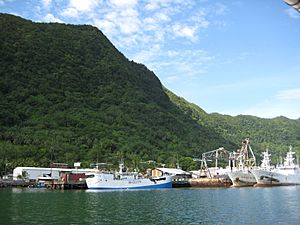
The economic health of American Samoa tends to reflect other U.S. territories. They depend on federal decisions. Tuna canning is the main way that American Samoa makes money. In the mid-1960s, American Samoa tried to start a tourism industry. They delayed the tourism efforts when they realized that it would cost the country more money that it would make. Agriculture and fishing still provide food for local families.
Most people in American Samoa are employed in one of three categories, which each have approximately 5,000 workers: the public sector, the single remaining tuna cannery, and the rest of the private sector.
There are a few federal employees in American Samoa and a few active duty military personnel. The Pele U.S. Army Reserve Center is in Tafuna, and a U.S. Army and United States Marine Corps recruiting station is in Nuʻuuli.
Most of the public sector employees work for the American Samoa territorial government. There used to be two tuna canneries in American Samoa: Chicken of the Sea and StarKist. Now StarKist is the only tuna cannery, and it exports several hundred million dollars worth of canned tuna to the United States each year.
| 2002 | 2003 | 2004 | 2005 | 2006 | 2007 | 2002–2007 AAGRA | |
|---|---|---|---|---|---|---|---|
| GDPB | 536 | 527 | 553 | 550 | 548 | 532 | −0.1% |
| Real GDPC | 527 | 535 | 539 | 550 | 534 | 537 | 0.4% |
| PopulationD | 60,800 | 62,600 | 64,100 | 65,500 | 66,900 | 68,200 | 2.3% |
| Real GDP per capita | 8,668 | 8,546 | 8,409 | 8,397 | 7,982 | 7,874 | −1.9% |
- A Average annual growth rate.
- B In millions of dollars.
- C In millions of 2005 chained dollars.
- D Source: 2008 American Samoa Statistical Yearbook.
In 2007, the Fair Minimum Wage Act of 2007 was passed. This act said that minimum wage in American Samoa would increase 50¢ per hour every year until it reached the same as the federal minimum wage of $7.25 per hour in the United States. Chicken of the Sea was not able to stay in business after the act was passed. Starkist began laying off workers in 2010, and they planned to lay off more people because of the minimum wage increases and other costs. American Samoa Governor Togiola Tulafono suggested that, rather than laying off minimum wage workers, companies could reduce salaries and bonuses of top-tier employees.
The unemployment rate was 29.8% in 2005, but has been improved to 23.8% as of 2010[update]. In 2017, American Samoa's GDP was $634 million. Its GDP per capita (PPP) was $11,200 as of 2016[update].
Like in other U.S. territories, some parts of telecommunications in American Samoa not as good as telecommunications in the United States. A recent estimate showed that American Samoa's Internet speed is slower than that of several Eastern European countries.
Interesting facts about American Samoa
- The National Park of American Samoa receives about 5,000 visitors a year.
- The largest concentration of fast-food restaurants is found on the American Samoa island of Tutuila.
- About three-fourths of American Samoans are considered obese.
- American Samoans are 56 times more likely to play in the NFL than men from the United States.
- About 80% of American Samoans are employed at tuna canneries.
- Canned tuna accounts for 93% of American Samoa's exports.
- Sea turtles have been given the name "l'asa," which means "sacred fish." They are said to have helped lost fishermen by swimming with them to shore.
- There is such a variety of fish in American Samoa that if a person were to swim around the reefs once every week, they could see a new fish species each time for eighteen years.
- A coral that is over fifteen feet tall and believed to be hundreds of years old lives off the coast of Ta'u island.
- The flying fox is one of only three mammal species in American Samoa.
- Research shows that it rains an average of 300 days a year in American Samoa.
- It is a tradition to bury the afterbirth (placenta) of a child near the family home in order to connect the child to the community.
Images for kids
-
Tuimanuʻa Elisala Alalamua, the last official titleholder of Tui Manuʻa (1899–1909)
-
Rear Admiral Benjamin Franklin Tilley, the first Governor of American Samoa (1900–1901)
-
Death of Fleuriot de Langle in 1787
-
English author W. Somerset Maugham stayed at Sadie Thompson Inn during his six-week visit to Pago Pago in 1916.
-
Cockscomb Point on Pola Island is seen jutting into the ocean.
-
A view of American Samoa's Ofu Beach on Ofu Island in the Manuʻa Islands
-
Jean P. Haydon Museum in Pago Pago
-
American Samoa at the South Pacific Games
-
The Samoa flying fox is only found in Fiji and the Samoan Islands.
-
The Blue-crowned lorikeet is the only parrot found in American Samoa.
See also
 In Spanish: Samoa Americana para niños
In Spanish: Samoa Americana para niños





